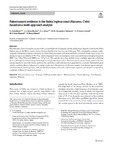Mostrar o rexistro simple do ítem
Paleotsunami Evidence in the Bahía Inglesa Coast (Atacama, Chile) Based on a Multi-Approach Analysis
| dc.contributor.author | Carballeira, Rafael | |
| dc.contributor.author | Peña Monne, J. L. | |
| dc.contributor.author | Otero, Xosé Luís | |
| dc.contributor.author | Sampietro-Vattuone, M. M. | |
| dc.contributor.author | Soto-Bauerle, M. V. | |
| dc.contributor.author | Pérez Alberti, Augusto | |
| dc.date.accessioned | 2022-06-02T09:22:11Z | |
| dc.date.available | 2022-06-02T09:22:11Z | |
| dc.date.issued | 2022-02-24 | |
| dc.identifier.citation | Carballeira, R., Peña-Monne, J.L., Otero, X.L. et al. Paleotsunami evidence in the Bahía Inglesa coast (Atacama, Chile) based on a multi-approach analysis. Environ Earth Sci 81, 153 (2022). https://doi.org/10.1007/s12665-022-10259-2 | es_ES |
| dc.identifier.issn | 1866-6299 | |
| dc.identifier.issn | 1866-6280 | |
| dc.identifier.uri | http://hdl.handle.net/2183/30835 | |
| dc.description | Financiado para publicación en acceso aberto: Universidade da Coruña/CISUG | es_ES |
| dc.description.abstract | [Abstract] The Atacama coast is located in an area with a current high risk of tsunami, and the sedimentary deposits found in the Bahía Inglesa area, in the Morro sector, clearly indicate that this was also the case in the past. This investigation analyzes a paleotsunami sedimentary deposit consisting of a block field associated with three sand lobes oriented towards land on top of a marine terrace at an altitude of 70–75 m, which originated from a tsunamigenic event occurred between interglacial periods MIS 7 (ca. 210 ± 10 ky) and MIS5e (ca. 125 ± 5 ky). The deposits have been studied using a multiple approach combining geomorphological, sedimentological, biological, and geochemical criteria. The first type of criteria clearly indicate that the energy required to move the blocks and form the sand lobes could only have been generated by a tsunami. Sedimentological criteria constitute direct evidences of a marine origin due to the presence of siliceous remains from diatom species and spicules from strictly marine sponges, while geochemical criteria, such as the stable isotope signature and chemical composition, constitute evidence of a marine intrusion. | es_ES |
| dc.description.sponsorship | Open Access funding provided thanks to the Universidade da Coruña-CISUG, trough CRUE-CSIC agreement with Springer Nature. The Consellería de Educación, Universidade e Formación Profesional of the Xunta de Galicia funded this research through the Axudas a consolidación e estruturacion de unidades de investigación competitivas do SUG del Plan Galego IDT, Ambiosol Group (2018-PG036). Rafael Carballeira is grateful for a PhD fellowship from the Xunta de Galicia (Plan I2C) | es_ES |
| dc.description.sponsorship | Xunta de Galicia; 2018-PG036 | es_ES |
| dc.language.iso | eng | es_ES |
| dc.publisher | Springer Nature | es_ES |
| dc.relation.uri | https://doi.org/10.1007/s12665-022-10259-2 | es_ES |
| dc.rights | Atribución 4.0 Internacional | es_ES |
| dc.rights.uri | http://creativecommons.org/licenses/by/4.0/ | * |
| dc.subject | Atacama desert coast | es_ES |
| dc.subject | Tsunami | es_ES |
| dc.subject | Cliff-top boulder deposit | es_ES |
| dc.subject | Marine terraces | es_ES |
| dc.subject | Geomorphology | es_ES |
| dc.subject | Geochemical signature | es_ES |
| dc.subject | Diatoms | es_ES |
| dc.title | Paleotsunami Evidence in the Bahía Inglesa Coast (Atacama, Chile) Based on a Multi-Approach Analysis | es_ES |
| dc.type | info:eu-repo/semantics/article | es_ES |
| dc.rights.access | info:eu-repo/semantics/openAccess | es_ES |
| UDC.journalTitle | Environmental Earth Sciences | es_ES |
| UDC.volume | 81 | es_ES |
| UDC.startPage | 153 | es_ES |
Ficheiros no ítem
Este ítem aparece na(s) seguinte(s) colección(s)
-
GI-GRICA - Artigos [49]






